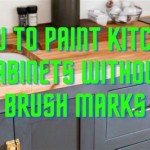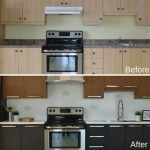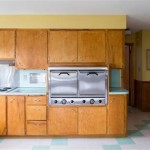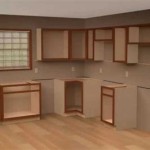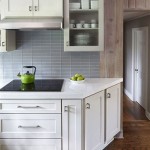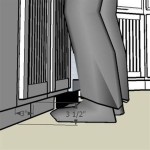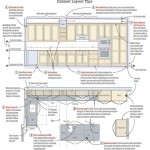How to Stain Particle Board Kitchen Cabinets: A Comprehensive Guide
Particle board kitchen cabinets can be an affordable and durable option for home kitchens. However, their raw appearance may not always match the desired aesthetic. Staining is a great technique to transform the look of particle board cabinets, giving them a custom and refined finish.
Materials Required:
- Sandpaper (120- and 220-grit)
- Tack cloth
- Wood filler
- Putty knife
- Stirring stick
- Stain (oil-based or water-based)
- Foam brush or rag
- Polyurethane finish
- Gloves
- Safety glasses
Preparation:
1. Remove cabinet doors and hardware. Clean the cabinets thoroughly with a damp cloth to remove dirt and grease.
2. Sand the cabinet surfaces with 120-grit sandpaper to remove any imperfections or existing finish. Use a tack cloth to remove sanding dust.
3. Fill any holes or imperfections with wood filler using a putty knife. Smooth the filler and let it dry completely.
4. Sand the filled areas with 220-grit sandpaper to create a smooth surface.
Staining:
1. Stir the stain thoroughly with a stirring stick. Use gloves and safety glasses for protection.
2. Apply a thin, even coat of stain using a foam brush or rag. Follow the grain of the wood for a natural look.
3. Allow the first coat to dry completely. Sand lightly with 220-grit sandpaper to remove any raised grain or imperfections.
4. Apply additional coats of stain as desired to achieve the desired color intensity. Allow each coat to dry completely before sanding.
Finishing:
1. Apply polyurethane finish to protect the stained surface. Use a foam brush or rag to apply a thin, even coat.
2. Allow the first coat of polyurethane to dry completely. Sand lightly with 220-grit sandpaper to smooth the surface.
3. Apply additional coats of polyurethane as desired, sanding lightly between each coat.
4. Allow the final coat of polyurethane to dry completely and cure for several days before reinstalling the cabinet doors and hardware.
Tips:
- Test the stain on an inconspicuous area first to ensure satisfaction with the color.
- Use oil-based stain for durability and water resistance.
- Apply thin, even coats of stain and polyurethane to avoid drips and runs.
- Allow ample drying time between coats and before using the cabinets.
- Clean brushes and rags thoroughly with mineral spirits or paint thinner.

How To Paint Laminate Cabinets Without Sanding The Palette Muse

How To Paint Pressed Wood Kitchen Cabinets Choice Cabinet

How To Paint Ling Paper Covered Cabinets Hometalk

How To Paint Particle Board Or Pressed Wood Cabinets

How To Paint Fake Wood Kitchen Cabinets Simple Made Pretty 2024

How To Gel Stain Fake Wood Furniture Laminate Mcm Night Stand Makeover

Transform Your Laminated Particle Board With Expert Staining Tips

How To Paint Pressed Wood Kitchen Cabinets Choice Cabinet

How To Paint Ling Paper Covered Cabinets Hometalk

How To Paint Kitchen Cabinets Without Sanding Or Priming
Related Posts

